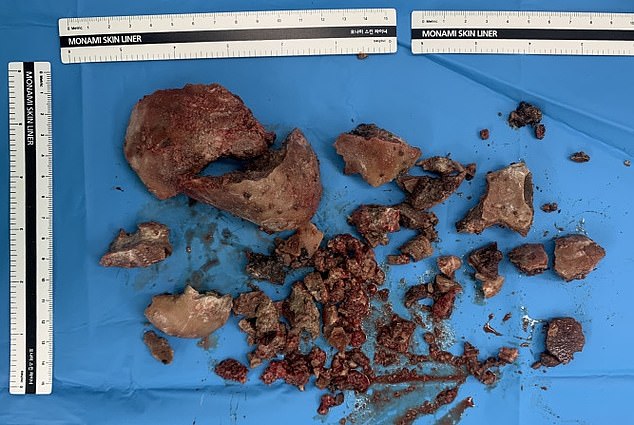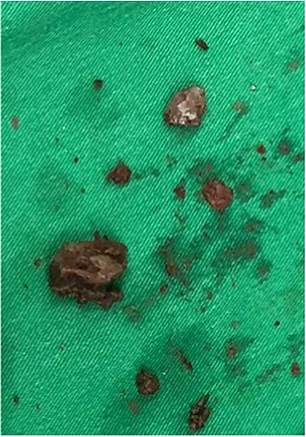EXCLUSIVE: Doctors discover a ‘vagina stone’ the size of a big orange lurking in the pelvis of a 27-year-old woman with agonizing tummy pain
- The woman presented to the doctors with illness, pain and fever
- The stone was fragmented into smaller pieces using a laser and then removed
- READ MORE: The world’s largest kidney stone ever
Doctors have reported an astonishing case of a young woman with a huge vaginal stone between her pelvic organs.
The stones are exceptionally rare, with fewer than 100 reported in recent medical literature.
They occur when stagnant urine builds up in the vagina and forms hardened crystals.
This is usually caused by an untreated bacterial infection. The insects react with chemicals in the urine to create an environment in which the fluid hardens.
People with diseases that often keep them bedridden are at greatest risk, as bacteria and urine tend to remain in the vagina for longer.
The woman, 27, had a huge vaginal stone in her pelvic area, doctors discovered

Another vaginal stone from another case in a patient from South Korea
The most recent case, reported in the journal Urological case reportsshowed a 27-year-old patient with cerebral palsy who was bedridden.
The woman visited the emergency department after developing a fever and chills that lasted for three days.
She also ate less than normal, vomited and had severe stomach pain.
The doctors said she looked pale and listless. A CT scan was performed on her abdomen and pelvis, and images showed a large, round mass in her pelvic area.

Once broken into pieces, the woman’s stone was removed with pliers during a three-hour procedure
To treat the problem, doctors – from the Lebanese University in Lebanon – used laser therapy to break up the mass. Ultrasonic shock waves were emitted from the device to the patient’s abdomen, on the outside of the body.
Once broken into pieces, the stones were removed with pliers during a three-hour procedure.
Because the stone was so large, it pressed against the woman’s bladder, reducing its capacity and leading to further leakage of urine.
A much more common type of crystallized stone is a kidney stone: these form in the same way as vaginal stones.
Hard clumps of minerals stick together in concentrated urine and form a stone.
About 11 percent of men and six percent of women will suffer from it during their lifetime.
They can be painful when passing through the urinary tract, but usually do not cause permanent damage.
The most common symptom is severe pain, usually on the side of the abdomen.
Cerebral palsy is often associated with urinary incontinence, which leads to constant leakage of urine into the vagina.
The term describes a group of conditions that affect a person’s ability to move and maintain balance and posture.
It is the most common motor disorder in children and causes debilitating, lifelong consequences, including difficulty walking, speaking, and performing basic motor tasks.
The condition is caused by abnormal brain development or damage to the developing brain, which reduces a person’s ability to control their muscles.
The woman had spastic cerebral palsy, which leads to muscle stiffness, especially in the legs, while the arms are less affected or not affected at all.
Scientists used to think the condition was caused by a lack of oxygen during the birth process, but now they think this only applies to a small number of cases.
About a million people in America have cerebral palsy, and about 10,000 babies are born with it every year.
The researchers said that patients with cerebral palsy who often lie down for long periods and have urinary incontinence are at risk of developing vaginal stones.
